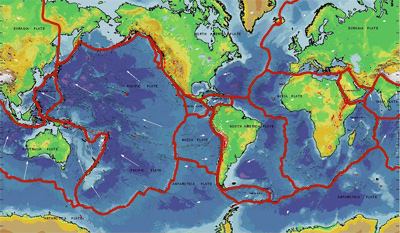
USGS and NPS
Related links:
Seismic Waves: Moving and Shaking During an Earthquake
Movie: Designing Earthquake-resistant Buildings
The Story of the 1906 Earthquake and Fires in San Francisco
Earthquake Information from USGS
Earthquakes for Kids from USGS
Study of Glacial Earthquakes Shakes Up Idea of How Ice Streams Move
What Is an Earthquake?
The ground underfoot might seem like it's not going anywhere but it is. It moves. If it moves all of a sudden the ground shakes. That's an earthquake!
Earthquakes happen as pieces of the Earth's crust move suddenly past one another at cracks called faults. Sometimes those pieces do not slide smoothly past one another. They get snagged on the rough surface of the fault. When the pieces of rock overcome the snags, there is an earthquake.
Each year, more than a million earthquakes happen. Most of these are so small that people do not feel the shaking. But some are large enough that people feel them, and a few of those are so large that they cause significant damage.
Earthquakes cause damage to buildings, bridges, and roads. Earthquakes can cause landslides and mudslides, too. If a large earthquake happens under the ocean it can cause a tsunami - a giant ocean wave or series of waves.
Scientists can figure out whether an earthquake is likely to happen in a place. However, unlike weather events, earthquakes can not be forecast ahead of time.














